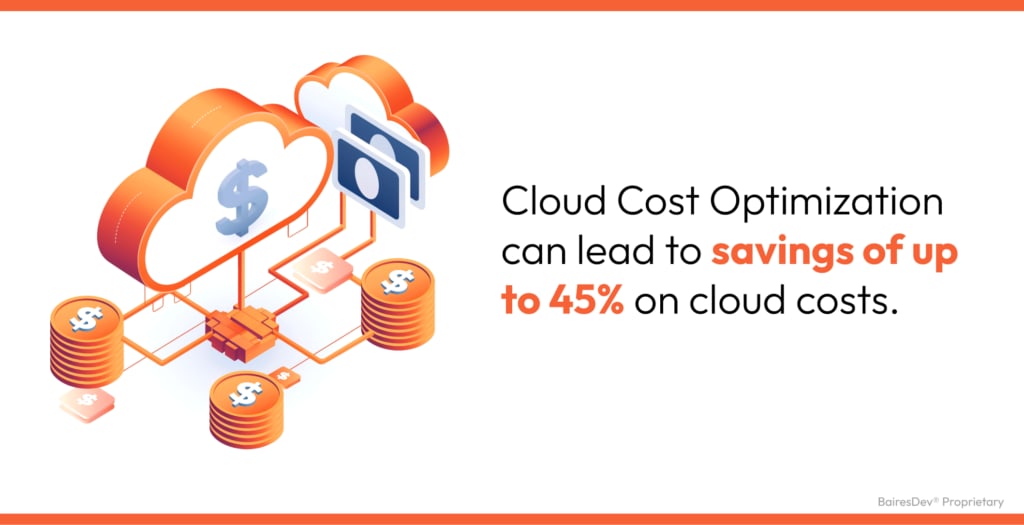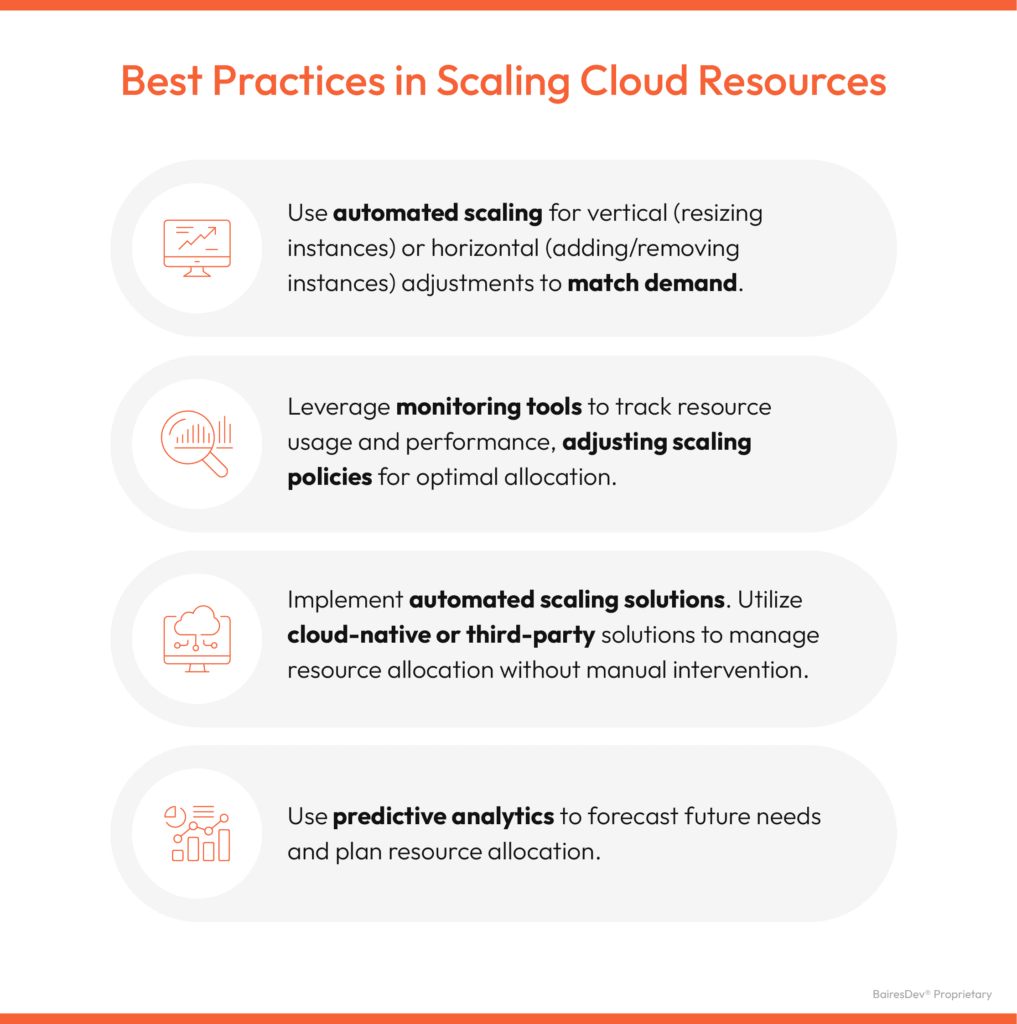Right now, cloud computing is at the heart of business operations, with data stored in the cloud expected to reach 100 zettabytes by 2025. This growth underscores the critical role of the cloud in data management and business strategy. Trends like serverless computing and FinOps are redefining efficiency, enabling companies to pay only for the resources they use.
In this context, cloud cost optimization emerges as a key strategy, not just for saving money but for reallocating resources towards more impactful areas, such as attracting and retaining top tech talent.
This article aims to provide tech leaders with concise, practical insights into optimizing cloud costs. We will explore how effective cloud financial management can not only drive technological efficiency but also foster a skilled workforce.
Defining Cloud Cost Optimization
Cloud cost optimization is the process of managing and reducing a business’s overall cloud spend. This involves identifying mismanaged resources, right-sizing computing services, and selecting the most cost-effective pricing models. It’s not just a cost-cutting measure but a strategic approach to maximize the value of cloud investments.

Why is it needed?
With their complex and varying pricing models, cloud services can lead to significant unplanned expenses. Effective optimization not only prevents overspending on underutilized resources but also enables the reallocation of budget towards innovation and talent acquisition.
Deloitte’s analysis suggests that effective cloud cost optimization can lead to savings of up to 45% on cloud costs, with the majority of these savings coming from consumption management and purchasing tactics.
For example, we have recommended our clients automation tools to start and stop non-essential instances during off-hours. Development and testing environments can be shut down overnight and during weekends. Another essential practice is to clean up unused or obsolete storage volumes and snapshots. You can shift infrequently accessed data to lower-cost storage classes, such as Amazon S3 Glacier, for long-term archiving.
Cloud cost optimization improves budgeting. Consider purchasing Reserved Instances (RIs) or locking in a Savings Plan for a 1 or 3-year term. You’ll snag a significant discount compared to on-demand pricing. Choose the commitment based on your steady-state usage. A practice we also recommend to our clients is to use cloud cost management tools to monitor and manage their spending proactively. These tools can identify inefficiencies, suggest optimizations, and help enforce policies to keep spending under control.
These practices allow businesses to adjust resources, and eliminate over-allocation. This is not a one-time activity but a new way of operating IT businesses, enhancing both operational and financial efficiency.
IBM emphasizes that cloud cost optimization should be a continuous process, integrating automation and analytics. IBM’s cloud computing optimization capabilities, such as Turbonomic, automate scaling to the correct VM (virtual machine) instance type and manage resources like storage and databases efficiently.
Imagine having a team of expert gardeners equipped with sensors and tools that detect which parts of your garden need more water, which plants need trimming, and when to fertilize for optimal health and growth. These gardeners work around the clock to keep each plant in its ideal state of health.
In the cloud garden, Turbonomic acts like these expert gardeners. It continuously analyzes your cloud environment, automatically adjusting resources like VM instances, storage, and databases. It ensures that each service is scaled to the right size and performance level, eliminating waste and ensuring cost-efficiency.
3 Key Strategies for Reducing Cloud Costs
While cloud services are nothing short of confusing from an outsider’s perspective, cost saving strategies are rather straightforward. They entail making sure we are using the right amount of resources, and that we aren’t losing money on unnecessary upkeep and storage, finding the most effective product for our current demand.
1. Resource Management
Regularly review and adjust resources to match actual workload requirements. This involves rightsizing resources, scaling services based on demand, and eliminating unused resources. Prioritize automation and monitoring for dynamic systems.
For example, we had a business partner who requested dynamic scaling for an e-commerce project with fluctuating demands around seasonal shopping spikes. We ensured optimal performance during peaks and cost-efficiency during lulls.
2. Waste Elimination
Audit cloud environments to identify and eliminate waste. We’ve worked on a number of cloud migrations and audits as companies have switched from on-prem data storage to the cloud. Simply put, it gets data to those that need it faster.
However, fast data comes at a cost. In these instances, our engineers have identified and eliminated old snapshots, unused instances, and redundant services associated with legacy applications. The cleanup and switch to efficient services cut our client’s monthly cloud expenses, showing why regular waste audits matter for cost optimization.
3. Leveraging Pricing Models
Make use of reserved instances, savings plans, and spot instances where appropriate to optimize costs. These pricing models can offer significant savings over standard on-demand pricing.
Consider a data analysis project requiring substantial but variable computing power. A good approach would be to use a mix of reserved instances for baseline capacity and spot instances for demand spikes This could capitalize on lower prices for reserved capacity and additional discounts for spot instances.
Redirecting Cloud Savings to Acquire Top Tech Talent
Efficient cloud cost management can significantly impact human resource strategies. This financial redirection can enhance the workforce within the competitive technology sector.
2023 Tech Industry Shifts: An Opportunity
The tech sector saw over 262,000 layoffs in 2023, involving giants like Amazon and Google. By January 2024, continued layoffs have freed up a pool of specialized talent. Businesses can capitalize on this by reallocating cloud savings towards hiring these skilled professionals. This strategy could position them for growth as the market recovers.
Tech Strategies for Attracting and Retaining Talent
A big investment opportunity is HR technology Take as an example our own AI-powered system that screens language proficiency in the early stages of the selection process. This has saved our acquisition team the valuable time they can invest in more thorough and specialized testing.
While attracting talent is essential, retaining is also vital. Essential strategies include competitive compensation, development opportunities, and enhanced work environments. A smarter way to reallocate resources is by looking into talent retention technology.
In 2023, we implemented a machine learning algorithm that improved our talent experience. This resulted in a 52% decrease in turnover year over year (YoY). This tool conducted research on the root causes of attrition risk. The result is valuable information our team can use to engage meaningfully with talent, leading to solutions focused on talent satisfaction.

Strategic Talent and Innovation for Agile Business Growth
Specialized talent partnerships offer businesses access to top-tier expertise. Through outsourcing, companies gain skilled engineers, cost savings, risk reduction, and faster delivery.
By optimizing your budget to address technology challenges, innovation goals, and growth opportunities instead of spending it on underutilized cloud services, your team can share knowledge and best practices in dynamic partnerships.
Overview of Popular Cloud Cost Management Tools in 2024
Now that we’ve touched on the many benefits and ways to make the best out of cloud cost optimization savings, let’s go through some popular tools to employ as a first step. In 2024, several cloud cost management tools stand out for their efficiency and features:
- Apptio Cloudability: This tool offers a robust cloud financial management platform focusing on visibility, governance, and optimization of cloud resources. It is particularly beneficial for its budgeting, forecasting, and rightsizing features.
- Microsoft Azure Cost Management + Billing: A suite of tools tailored for monitoring, allocating, and optimizing Microsoft Cloud workloads. It provides detailed reporting and proactive cost monitoring features.
- Densify: Known for its machine learning recommendations, Densify optimizes cloud resources across various environments and delivers optimization-as-code.
- Harness: A continuous integration and delivery platform that enhances cost transparency, optimization, and governance. It provides detailed visibility into Kubernetes clusters and cloud spend.
- IBM Turbonomic: Focuses on automated real-time actions to efficiently use compute, storage, and network resources. It is beneficial for avoiding overprovisioning but can be complex to configure.
- Tanzu Cloudhealth: Manages cloud costs, usage, performance, and security. It offers comprehensive tools for managing, analyzing, and optimizing cloud infrastructure and spending.
- Flexera: Known for its actionable recommendations, budget controls, and cost policies, Flexera offers automation tools for efficient cloud optimization and governance.
- CloudCheckr: Provides detailed cloud cost allocation data and predictive analytics for rightsizing and snapshot cleanups.
Conclusion
After the massive growth of cloud technologies during the 2020’s pandemic, we are seeing more and more companies leaving the cloud in what some experts are calling cloud repatriation. This isn’t the end of cloud services; rather, many companies are realizing that, like any other tool, cloud services aren’t a one-stop solution. Shop around to find options that fit your needs and economize with automatic scaling.
This, plus the fact that server hardware prices are dropping, has companies reallocating their resources to other areas, like acquiring and retaining high-tier talent: An excellent strategy in the context of massive tech layoffs that are filling the market with young and experienced talent ready for new opportunities.









